Please choose your country or region so we can show you the most relevant content.
It looks like you are in United States? Accept
Africa
- Algeria
- Angola
- Benin
- Botswana
- Burkina Faso
- Burundi
- Cabo Verde
- Cameroon
- Central African Republic
- Chad
- Comoros
- Congo
- Côte d'Ivoire
- Djibouti
- DR Congo
- Equatorial Guinea
- Eritrea
- Eswatini
- Ethiopia
- Gabon
- Gambia
- Ghana
- Guinea
- Guinea-Bissau
- Kenya
- Lesotho
- Liberia
Asia
Australasia
Europe
- Albania
- Andorra
- Austria
- Belarus
- Belgium
- Bosnia and Herzegovina
- Bulgaria
- Croatia
- Czechia
- Denmark
- Estonia
- Finland
- France
- Germany
- Greece
- Greenland
- Holy See
- Hungary
- Iceland
- Ireland
- Italy
- Latvia
- Liechtenstein
- Lithuania
North America
Middle East
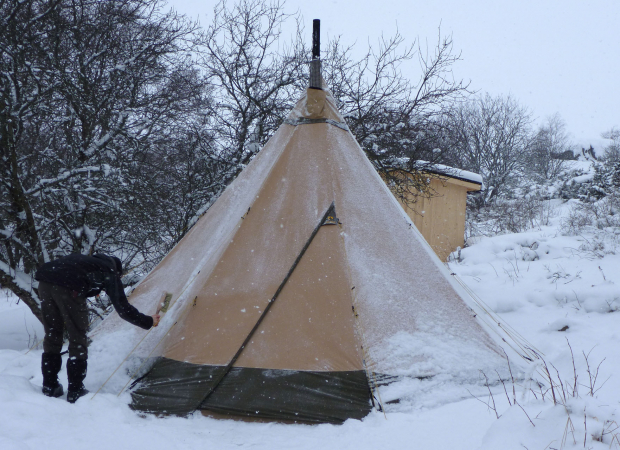
Adventure Camping Lifestyle Winter camping Living in a Nordic tipi
One Year in Our Tentipi Nordic Tipi
10 Apr 2013
Have you ever returned from a weekend trip to the country; the mountains; the sea, just wishing to extend the experience a while longer? Here’s a charming story, sent in by Jarmo and Laura Järvinen, who did just that. And then some.
Their 12 month stay on an island in the archipelago of Åboland in the south of Finland sounds like a magical reconnection with a simpler way of life, and one we might all learn from. If a 12 month break is a bit much right now, their post contains many useful tips for your shorter breaks too.
For more of their photos see the Tentipitents Facebook Album.
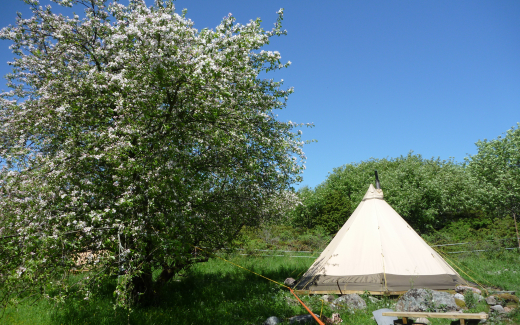 |
| Springtime in our campsite. |
How it all started
“I don’t think either of us can remember exactly how we came up with the idea of spending a year in a Nordic tipi. At first, it was just a vague dream but then we started to discuss it more seriously. Of course, our initial reaction to such an idea was “No! Impossible!” But then we began to think “Why not?”. After the first mention of the idea sometime in the Autumn, things moved very fast. We found the perfect place where we could put up our Nordic tipi: a sheltered valley on a neighbouring island in Åboland’s archipelago in southern Finland. About 15 people live on the island which has an area of about one square kilometre. There is a ferry service to the island several times a week. We were able to rent a piece of land and also got permission to build an outdoor privy there.
We had no problem finding the right tent. Jarmo had come in contact with Tentipi’s Nordic tipis through his job as a wilderness guide so it was just a matter of choosing the model that would suit us the best. With the help of Tentipi’s staff, we chose the Safir 9 cp model. It seemed to be just the right size for us (about 15 square metres) and easy to move. We ordered a Safir Nordic tipi and a stove which were delivered in early November. Before we could pitch the Nordic tipi, we had to build some sort of wooden floor, like a terrace, that would protect us from cold and damp from the ground. We also built our outdoor privy and ordered some firewood.
When you move from an ordinary two-room apartment to a Nordic tipi that is about 15 square metres big, you have to radically reduce your possessions! We sold a lot of our stuff in flea markets and gave away furniture to anyone who wanted it. When we packed up our remaining possessions, we still had a trailer full of boxes. But now we only had stuff that we really needed — or so we thought…
We tested one night in the Nordic tipi at the end of November. There was a strong wind blowing — almost 20 meters per second — and, with no proper bed yet, we slept on the floor. But it felt very exciting and good fun and we started to long for the New Year which was when we planned to move in to our new home.
Winter
Winter came more or less the same day that we moved in. And what a winter it was! There had not been so much snow and ice in that area for decades. But it was great for us because we were really able to find out what it is like to live in a Nordic tipi in winter.
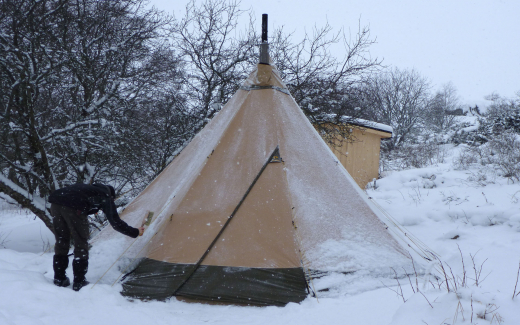 |
| Winter arrives in Southern Finland. |
Normally, it takes a while for the human body to get used to cold. Yet we were both surprised at how quickly we acclimatized. We slept in sleeping bags and had no fire burning at night so it wasn’t difficult to wake up in the morning and go out to the privy without putting on outdoor clothes. But later we discovered it was hard for us to be in normal room temperatures when we were constantly exposed to sub-zero temperatures. The cold in itself is not dangerous; it is simply something you have to bear in mind. It’s important to make sure your body gets enough energy, warm liquid and rest. We had enormous appetites throughout the entire cold period! We had built a “fridge” under the floor, an old barrel that was dug down into the ground, and our food did not freeze there. Our menu consisted mainly of stews and soups because they warm you up so well and contain a lot of liquid. We always drank warm water. If you drink cold water in cold temperatures, you can feel really ill. It’s easier for the body to take warm water.
Our daily activities were very simple: we fetched water from the village, cooked food, chopped firewood, prepared split wood, etc. All everyday chores took much longer than they do in a modern household. Making dinner meant first chopping wood, then making a fire and then actually cooking the food. After eating, we had to heat water in order to wash up etc. But we enjoyed the whole process! It was strange but that simple way of life felt so right.
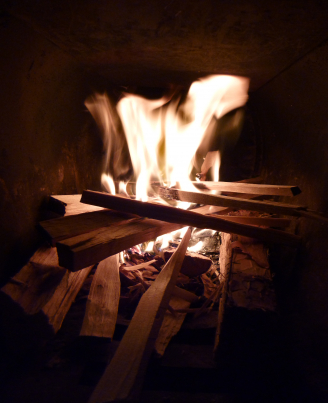 |
| Fire becomes central to our lives. |
Of course, we were also able to enjoy this fantastic, icy season. We went on outings to other islands, skied across the ice and fished. Even though we didn’t have a fire at night, we still used up quite a lot of wood. We didn’t want to be cold and uncomfortable when we were cooking, for instance, so we had to order more firewood. Because the ferry could no longer moor at the jetty, they had to lower the wood onto the ice and then the friendly islanders helped us bring it home.
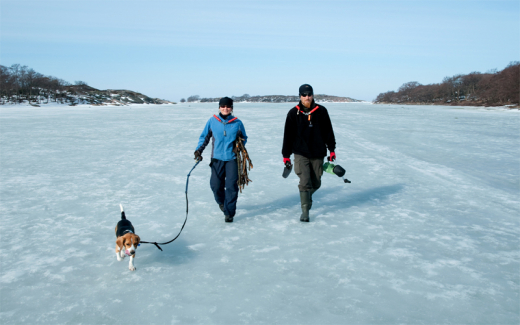 |
| Typical outdoor day. |
It was a surprise for us to see just how light it really is in winter. In a town, the street lights go on early afternoon in winter which makes it seem very dark straight away. The contrast between the street lights and twilight is so great that the sky actually looks very dark. But where there is no street lighting, you can enjoy the soft, beautiful twilight and see how the sky gradually gets darker and darker and the stars begin to twinkle.
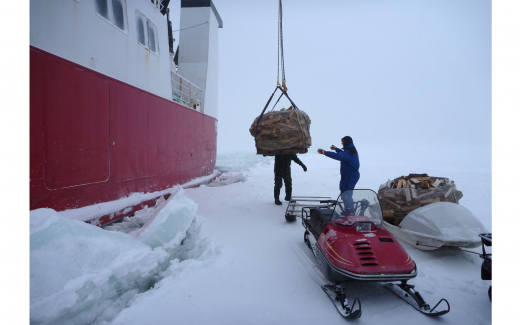 |
| Our firewood arrives! |
Another surprise for us was a feeling of “detachment” when it came to current affairs and what was going on in other parts of the world. Because we didn’t have any newspapers and no electricity for a radio or TV, we didn’t have a clue about what was on the news. And the strange thing was that we didn’t miss it at all. We always got to know the most important things anyway because when we walked to the village, the other islanders told us the main news items. But that was enough. We did ask ourselves just how much unnecessary information modern man is subjected to. Winter in the Nordic tipi was a pleasant surprise in many ways. It was not at all cold, nor was it boring or difficult to live in the tent. Instead it was very interesting and good fun.
Spring
When did spring come? Perhaps it was when the ferry came to the jetty at Easter — for the first time in two months. Or perhaps it was when the snow melted and it was suddenly so wonderfully easy to walk on bare ground instead of sinking down into the snow with every step. Or maybe it was when the night temperature crept up towards zero and we could pack away our sleeping bags and use sheets instead. It’s hard to say exactly when spring came but suddenly it was there, with greater force than ever!
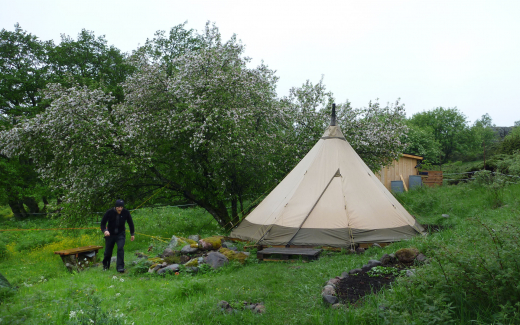 |
| Spring arrives, and with it, the blossom. |
We were living in the bosom of nature, day and night. We were able to see, hear, smell and feel even the most tiny changes around us. And it was fantastic! One of our most memorable experiences was hearing the birds. During the winter we had listened to the wind, the waves and the sound of the ice before going to sleep. But in the spring, the sounds around us changed radically. First there was a single blackbird singing in the evening outside the Nordic tipi. But soon we were surrounded by birdsong! Sometimes it was difficult to sleep because the singing was so loud! It was like listening to a never-ending concert with beautiful, different birdsongs. Sometimes the birds sang so much at night that we both woke up at four o’clock! And it was not just the birds’ singing that we heard inside the tent; it was also the sound of their wings. For us, the birds were also of great symbolic significance. The “silent and lonely” winter was over. First it was just the two of us and a few hares and swans; then all the migratory birds came, and not long after that, the boaters started to come to the island.
All the snow turned into water which meant that it was very wet and muddy around the Nordic tipi. It also rained a lot, especially in April. Yet it didn’t get any damper inside the tent. We were surprised. We knew that it had been dry in the winter because of the cold temperatures but we didn’t have any problems with damp in the spring either. If there was a little condensation on the walls on very rainy days, it dried off as soon as we made a fire in the stove.
There were not just birds that visited us. After we had been away to visit some relatives, we came home and found traces of mice. They had had a real party in our “house”! We took everything out of the tent and decided to do a proper spring clean at the same time. That resulted in several more boxes with stuff for the flea market! When we moved into the Nordic tipi, we thought we had taken only the bare essentials with us but after a few months, we had learnt what we really needed. After this incident with the mice, we were extra careful to keep everything in boxes with lids.
We were also visited by some vipers that lived under the floor. Luckily they never came into the Nordic tipi; they stayed outside. The animal visitors we liked the most were probably the cows that came to the island to graze during the summer. Ten cows came to our island in May and ten others were taken to a neighbouring island. But after three days, all the cows were on our island; naturally they all wanted to be together!
Summer
The spot we had chosen was very well protected in winter. Even during the most fierce storms, everything was fine and we were not cold. But in the summer — gosh! Then our valley was hot! The air stood still and we woke up at seven every morning, dripping with sweat. We didn’t use the stove at all in the summer. We cooked our food on a Trangia stove.
The weather is seldom wrong but sometimes you try to do things in unsuitable circumstances. So we decided to adapt ourselves to the fact that the weather was warm. We slept in the Nordic tipi but were outdoors during the day. That was the best solution we could think up. We went on outings, we canoed, went swimming, and helped people in the village. Then in the evening we walked back to our Nordic tipi. It’s really good that there is a mosquito net fitted to the tipi door. That meant we could air it all day.
The mosquito net was functional in other respects too because there were many insects outside the Nordic tipi. But none inside! A couple of times each summer, the air gets filled with flying ants. That happened this year too but this time we experienced them much more close up than we normally do. It sounded as if it was raining but it didn’t rain water; it rained flying ants! Most of them stayed outside; only one or two got in through the chimney.
In the winter, our Nordic tipi was clearly visible from the nature trail which passes by about fifty metres away. But in the summer, the vegetation was so dense that very few tourists discovered the Nordic tipi. Maybe some people did visit it when we were out and about somewhere but that didn’t bother us. They left us alone. But there were a lot of people in the village and after the quiet winter, it was nice to see people and have a chat. It’s always like that in the archipelago — after winter, it’s great to see tourists and then after summer, it’s nice to have peace and quiet again. We were asked many, many times to describe our way of life in our Nordic tipi. People were fascinated to hear about our decision to live like that and we had a lot of interesting discussions. It does seem that many people are of the opinion that our modern, Western lifestyle is not that good. Quite a few even said that they were inspired by us. That was a good feeling!
In the spring we had made a little garden where we grew herbs, different types of lettuce, tomatoes and other vegetables. Everything was fine until the water in the nearby well dried up. The well was old and in disrepair and the water was not drinkable but it could be used in the garden — as long as there was water, that is. We didn’t have a drop of rain from early June until September. Nevertheless, we still got a small harvest but we decided to repair the well for next summer if we fancy growing something in our garden then.
Living in a Nordic tipi in the summer was very easy, more or less like living in a cottage.
Autumn
After the hot summer, we eagerly welcomed autumn! The temperature was just right; we were able to start making a fire in the stove again and could cook our food on it too. First the tourists left, then the migratory birds, then the cows and finally the leaves from the trees. Now it was just us again. We started to get hard winds again. And rain. But it all felt familiar to us in a way. Over the year, we had got accustomed to all different kinds of weather. We no longer needed to worry that the Nordic tipi might blow away in a storm — we had learnt that we could rely on it.
Now we enjoyed going for long walks in the rain, coming home again, making a fire in the stove, boiling up water for tea and then sitting reading aloud from some interesting book. We enjoyed every moment! We also liked the fact that the evenings were now dark. We were able to light our oil lamps again and enjoy the soft, gentle, light they spread.
The autumn was probably the most harmonious period of our year in the Nordic tipi. We had got accustomed to our way of life there, everyday chores were easy, and we had had time to fix everything that needed fixing. We had precisely the equipment we needed — no more, no less. And we were short of nothing!”
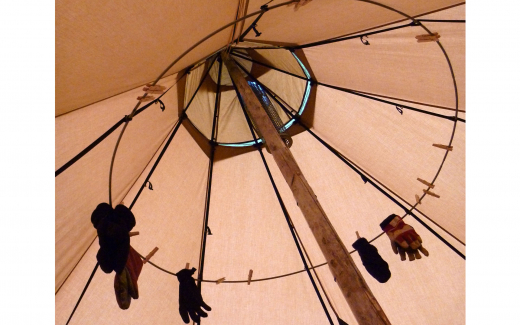 |
| Our trusty Safir - all year round comfort. |
Related blog posts
It was the first day of the trip, adventurer Mike Fuchs and his friend Eric Folz had just a couple of hours before been dropped off as far north as they could possibly come in Svalbard when they saw them. Two polar bears, one mother and its cub. A situation that could become deadly if the bears decided to have a closer look on their new visitors.
“I know how protective the mothers can be of their cubs. We had to set up our camp in a place that provided a good overview of the location so we could spend the night bear watching. It was both a scary feeling seeing them so early into our trip, but it was also very fascinating”, says Mike Fuchs.
Wouldn't it be exciting to spend the night right in the middle of a zoo? – That is exactly what you can do at Skånes Djurpark, a wildlife park in southern Sweden. At their campsite, Camp Oak, you stay in the park after it closes and will make yourself at home in a Nordic tipi from Tentipi. When the night comes you might just fall asleep to the wolves’ howls.
Skånes Djurpark is a Wildlife Park with a long history, it dates back to 1952. It focuses on animals from the Nordic area and has always lived by the ruling with “no animals in cages”. The animals live in large paddocks that recreates the animals’ natural environments.
Lennart Pittja is a Sámi entrepreneur with a mission: with his world-renowned eco-tourism company he wants to spread the knowledge about his people – the Sami, indigenous of northern Scandinavia and Russia. With over 20 years of experience as a wildlife guide and nature photographer in the arctic region he started Sápmi Nature Camp. Where his guests stay in Nordic tipis from Tentipi on his reindeer herding land outside of Gällivare, in northern Sweden.
At Sapmi Nature camp you can experience real winter, see the northern lights, eat traditional Sami food, and have a cultural exchange in a genuine atmosphere. The scenic location has gained attraction from around the world. In 2017 it was listed by National Geographic as one of the top 21 places in the world to visit if you care about the planet.
Prepare before setting out for winter camping. Here are nine tips and tricks from Tentipi about what you need to think of before you go: the right tent for winter camping, how to pack the snow, comfort in snow, which tent pegs to use, where to pitch the tent, about snow weight, what heat sources can be combined with the tent, how to make a fire safely and other equipment.
Choose tents according to occasion, different tent types work differently at winter camping. When it’s icy, the tent needs to be more robust than a tent which is exclusively used in summer. The tent frame needs to withstand a certain amount of snow and functional ventilation is important. If you want to use a heat source, for example a fireplace or a stove, the tent needs to have ventilation openings both at ground level and at the top. Without a heat source, a smaller tent is preferable, as it heats up faster when the air volume is smaller.
A tent from Tentipi is a Nordic tipi and the tent has eight or nine sides, if it is not the smallest that has six sides. In the smallest tent you can stand straight if you are less than 160 centimetres long and in the largest you can get together several thousand people. The tent is versatile in more ways. Continue to read to see why these tents are so flexible and adaptable. This blog post is about the smaller tents in Tentipi's range, tents used by adventurers, families, hikers and others who want to live close to nature for a shorter or longer period of time.
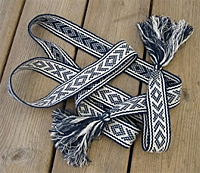
Sami cultural band
The Sami are a nomadic, indigenous people in northern Scandinavia. They are known as the people of the sun and the wind. Some Sami still work as reindeer-keepers. Traditional Sami clothes are decorated with colourful, woven bands and bands like this used as shoelaces.
Use fire safely!
Use fire safely!
Tentipi® Nordic tipis are designed to be used with an open fire or stove; it is this feature that makes them a home from home in all weather conditions. But please check local regulations, read and understand the instructions provided, and make sure you are fully competent to deal with the risks involved, before striking that match.
Tentipi® is a registered trademark of Tentipi AB












